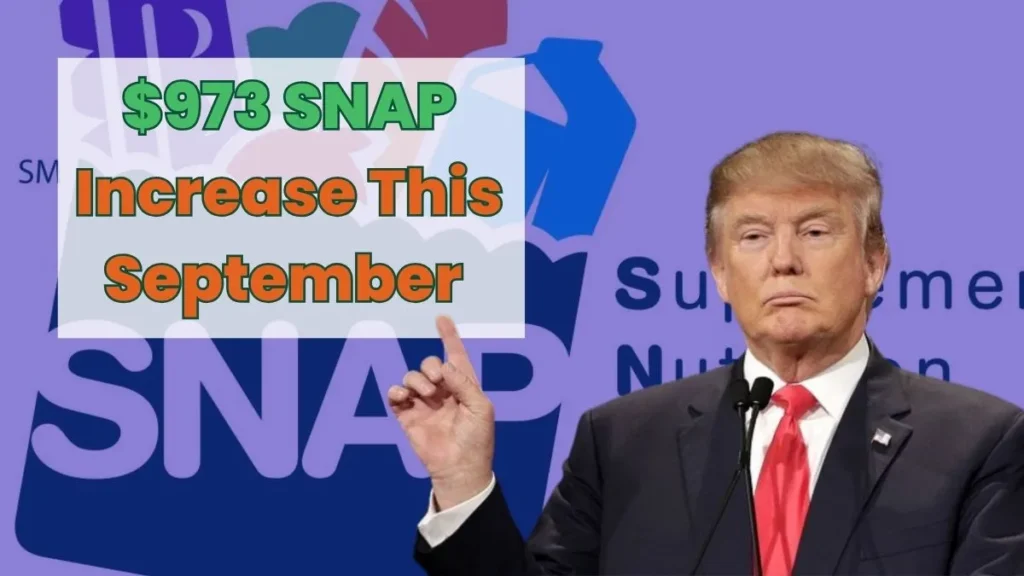The $973 SNAP Increase coming this September is one of the most talked-about updates in U.S. benefits. Millions of Americans depend on the Supplemental Nutrition Assistance Program (SNAP), commonly known as food stamps, to put meals on the table. With inflation, rising grocery prices, and a higher cost of living nationwide, this boost couldn’t come at a better time.
According to the U.S. Department of Agriculture (USDA), the maximum monthly allotment for some families will rise to $973. But not everyone qualifies. In this article, we’ll break down who is eligible, how benefits are calculated, and what this increase means for households across the country.

1. Understanding the $973 SNAP Increase
The $973 SNAP Increase is part of the 2025 cost of living adjustment (COLA). SNAP benefits are recalculated annually to keep up with inflation and rising food costs. For larger households, the maximum allotment in September rises to $973 per month. This means families can expect more support when purchasing groceries through their Electronic Benefit Transfer (EBT) cards.
- The adjustment helps low-income families keep up with food inflation.
- The increase applies to households that meet income and eligibility limits.
- Families will see the higher benefit amount automatically loaded onto their EBT cards.
This change shows the government’s effort to ensure SNAP remains a safety net for those most affected by economic challenges.
2. Who Qualifies for the $973 SNAP Increase?
Not all households will see the maximum $973 SNAP Increase. The amount you receive depends on your family size, income level, and state of residence. Larger families generally qualify for the higher benefit levels, while smaller households see lower allotments.
| Household Size | Maximum SNAP Benefit (Sept 2025) |
|---|---|
| 1 person | $291 |
| 2 people | $535 |
| 3 people | $766 |
| 4 people | $973 |
| 5 people | $1,155 |
| 6 people | $1,386 |
To qualify, households must meet USDA income requirements, which are based on the federal poverty line. States may also adjust eligibility slightly based on local cost of living.
3. Income Limits and Eligibility Requirements
To receive the $973 SNAP Increase, applicants must meet strict income guidelines. SNAP eligibility is based on gross and net monthly income compared to household size. For example, a family of four must have a gross monthly income below $3,250 to qualify.
- Gross income = total household income before deductions.
- Net income = gross income minus allowable deductions (such as housing or childcare).
- Assets such as savings accounts may also affect eligibility.
Households that already receive benefits do not need to reapply to get the September increase. The USDA will automatically adjust benefit amounts for qualifying families.
4. How SNAP Benefits Are Paid Out
SNAP benefits, including the $973 SNAP Increase, are distributed through an Electronic Benefit Transfer (EBT) card, which works like a debit card at grocery stores, farmers markets, and approved retailers. The funds are deposited once per month on a scheduled date, depending on the state.
- Benefits cannot be withdrawn as cash (except limited cash options in certain states).
- EBT cards can only be used for food purchases, not alcohol, tobacco, or household goods.
- Unused benefits roll over to the next month but must be used within 12 months.
This payment system ensures families have easy and secure access to their food stamp benefits.
5. Why the Increase Matters in 2025
The $973 SNAP Increase comes at a critical time when grocery costs remain high nationwide. According to the Bureau of Labor Statistics, food prices have risen nearly 7% over the last year. Without this adjustment, many low-income families would struggle to afford essentials like milk, eggs, meat, and produce.
- It helps reduce food insecurity.
- Families can buy healthier food choices instead of cheaper, less nutritious options.
- It injects money back into local economies as households spend benefits in neighborhood stores.
For millions of Americans, this increase is not just financial support—it’s peace of mind.
6. State Variations in SNAP Benefits
While the federal government sets overall guidelines, states manage SNAP programs individually. That means the $973 SNAP Increase may vary slightly by location. States like Alaska and Hawaii, where the cost of living is higher, already offer larger SNAP allotments compared to the lower 48 states.
| State | Max Benefit for 4 People (Sept 2025) |
|---|---|
| Mainland U.S. | $973 |
| Alaska | $1,487 |
| Hawaii | $1,412 |
| Guam | $1,244 |
| U.S. Virgin Islands | $1,126 |
Checking your state’s SNAP website will give the most accurate breakdown for your household.
7. How to Apply for the $973 SNAP Increase
If you think your household qualifies for the $973 SNAP Increase, applying is straightforward.
- Visit your state’s SNAP office or apply online.
- Submit proof of income, household size, residency, and expenses.
- Wait for your application to be reviewed—most states give a decision within 30 days.
- If approved, benefits are deposited monthly on your EBT card.
Households already enrolled do not need to reapply—the new allotment will automatically update in September.
Conclusion
The $973 SNAP Increase offers much-needed relief for families struggling with rising food costs this September. While not everyone will qualify for the maximum benefit, larger households that meet income requirements can expect this boost. With benefits distributed automatically through EBT cards, families will notice the difference right away.
For millions, this increase means healthier meals, less financial stress, and more stability. If you’re unsure about eligibility, check your state’s guidelines to see if you can take advantage of this food stamp increase.